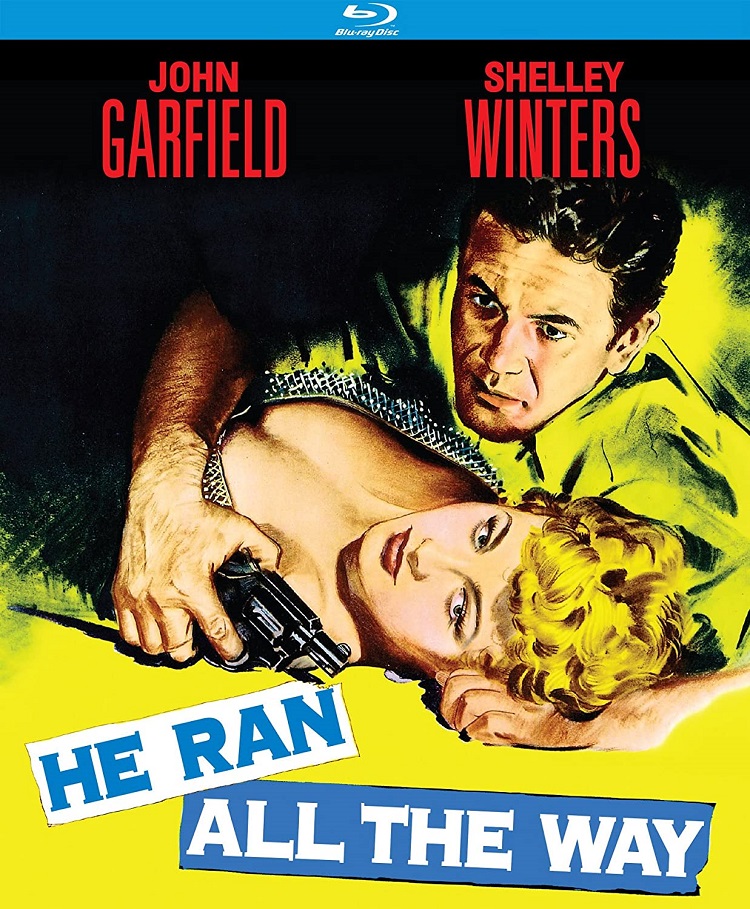
He Ran All The Way was written by Dalton Trumbo and directed by John Berry, both just before they were blacklisted in Hollywood as Community Sympathizers after the HUAC hearings. Try as I might, I couldn’t find much Red propaganda in the film. What I did find was a taut, beautifully shot little thriller about a guy who terrorizes and invades the home of a girl who, had he met her just the day before, he would have probably dated her for a while, maybe even got married. It was a mess of circumstance and bad habits and pretending to be something he wasn’t that turned his life down all the wrong corners.
John Garfield, in his final film appearance before dying of a heart attack at age 39, plays Nick Robey, a guy on the skids with no discernible talents, not much in the way of brains, and who lives with his drunk mother in a crappy apartment. He’s got one friend in all the world, a petty criminal named Al Molin who strong-arms Nick into doing a job with him, and bringing a gun on it. They’re trying to steal payroll for some operation, but just their luck: a cop is right outside the building where they lie in wait, hears the scuffle and comes in shooting. Al is shot. Nick returns fire and hits the cop.
Then, money in hand, he rushes off to hide at a local public pool. There, splashing around disappearing in a crowd, he’s nearly bowled over by Peggy Dobbs, played by Shirley Winters.
One of the man distinctions between a gangster story and a film noir is that in gangster pictures, there’s a rise and a fall. The gangster is good at something, even if it’s just in being the meanest guy around. Film noir is not about the successful ultimately failing, but the mostly mediocre trying to take one step out of line, and finding a freight train of trouble barreling down after them. It’s what makes these kinds of films so often compelling, and so often bleak. A rise and fall story has some guaranteed fun – you get to live vicariously through the bad things the gangster does, then purge your enjoyments through his eventual downfall. Noir starts low and falls further.
So Peggy isn’t just a quiet, mousy girl Nick Robey bumps into. She’s a sheltered thing, pretty but completely unaware of it – a spinster in training. She can’t swim, but she comes regularly enough to the pool that she can make a date with Nick to see him there again. Nick gives her a few pointers, and they start off sweet until he sees a cop, and starts getting mean to her for no reason. And she lets him, and doesn’t mind too much when he grabs her again coming out of the pool. He takes her home, which turns out to be her parent’s home – she’s too old to still be living there, but hasn’t found anything to take her out of the house.
It’s there he finds out that the cop he shot has died, and through a series of stupid mistakes reveals to the family just what he’s done – and now he has to keep them in the house, under his watchful eye, before he comes up with some kind of plan. He is not a very good bad guy – he doesn’t have the nerves or the heart for it, and basically wants the people that he’s keeping prisoner in fear for their lives and the lives of their children – to like him. Peggy, however guilty she feels for bringing this down on her family’s heads, can’t get over some part of herself that is attracted to the violence, even as she’s repulsed by it.
All of this action unfolds is some of the most beautiful black and white photography imaginable. Really black and white, too – cinematographer James Wong Howe shoots with shadows black as pitch, even out in the bright sunlight. I’m a big fan of Blu-rays all around, but I find I appreciate most how the resolution makes both animation and black and white movies, where one is more likely to encounter solid blocks of the same color on screen for long periods of time, really pop. Howe’s stark, beautiful images elevate He Ran All The Way from a small, competent thriller into something darker, and edgier.